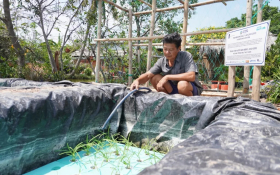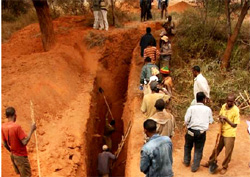Stockholm Water Week: Dutch seminar on effective climate adaptation and urban water buffering
This year Stockholm World Water Week has the theme Urban Water Challenges. The Dutch 3R consortium organizes a special seminar on this subject on Sunday August 21. The seminar is titled 'Integrated Management of Urban Water Buffering: From Research to Implementation' and addresses a very practical approach for climate adaptation in relation to water management". The 3R-concept is based on three steps: recharge, retention and reuse. During the seminar many examples will be shown of water buffering in Bangladesh, Jordania and Namibia. Furthermore management methods will be presented, based on international research and praticial experiences.
Many invited partners
3R is an initiative that is being developed by a consortium of Dutch water partners, as an effective and marketable approach for climate change adaptation. Participants in the consortium are Acacia Water, Aqua for All, MetaMeta and the Rain Foundation. For the seminar in Stockholm the consortium has invited other partners, notably the World Agroforestry Centre (ICRAF), Southern and Eastern Africa Rainwater Network (Searnet) and the Bundesanstalt für Geowissenschaften und Rohstoffe (BGR) .
Three subsequent steps: recharge, retention, re-use
At the core of the 3R concept is the buffer function that groundwater provides – allowing one to deal with peaks and lows in water access and the increasing variability that many areas are expected to experience with climate change. 3R involves managing this buffer function through 3 subsequent steps – Recharge, Retention and Re-use.
The primary objective of 3R is the scaling up of appropriate 3R solutions in order to buffer water during the dry periods in water scarce areas.
Many technical solutions
There are a large number of possible (technical) solutions to achieve this which we have grouped under the name 3R, covering the broader process of retaining and intercepting rainfall and runoff, conserving it in the soil or storing it underground to supplement the groundwater, or in tanks at appropriate places for its re-use during dry periods.
Linking with land use planning
The approach behind the 3R concept is that addressing a local water crisis is not so much about allocating scarce water, but rather about extending the temporal availability of the water within a basin. 3R is an approach to upscaling.
It’s focus is not on an isolated intervention but instead the improvement of water storage within the entire hydrological unit to provide water for domestic and economic use, while making a link between land use planning (roads, drainage, gravel/ sand mining etc.) and natural and artificial recharge management.
Integration of hydrological information
Large scale planning of 3R systems is based on the successful integration of hydrological information, up to date tools and methods (satellite images and spatial data bases), the technical, environmental and financial feasibility of 3R components, integration of proven local solutions and knowledge of the socio-economic, organizational and institutional setting. This knowledge and set of tools are collectively offered by the consortium members to enable the development and implementation of the 3R programme.
More information: www.bebuffered.com




